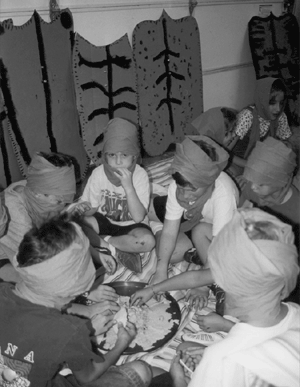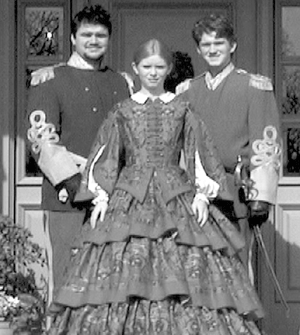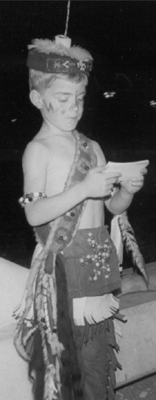It is Friday and Linda is dropping her three oldest off at co-op. She feels like a free woman. Co-op allows her to spend the day running errands and reading to her little guy one-on-one. Along with many other great benefits, co-oping offers the best of both worlds... homeschool and classroom perks.
Shared Time and Energy
Tonight my two American history co-ops plus all their parents are staging an Underground Railway. The "slave" students are being spirited away from chopping cotton in my fields at dusk, covered with blankets in the backs of vans (no wagons available), and hidden in three safe houses nearby. From there the slaves will attempt to cross fields, meet mom conductors, warm themselves by friendly fires, and avoid being caught by dads playing the role of slave catchers, some even on horseback. This will be a riveting, unforgettable experience! Once everyone has arrived back at the plantation home, students will show their crafts, eat goodies, and share thousands of "near-miss" stories that will pour from the night's events. I will have no trouble getting the students to write a paper about the Underground Railway next week. It will be part of them. Never in a million years could I pull off this fabulous event as one family, but many families co-oping together will stage history in an exhilarating, memorable way.

|
|
Eating Injera
|
Breaks for Mom
Sharing time and energy is not just for huge events. It is equally beneficial for Mom's sanity once a week. If I have six or seven other children coming to my house to learn about Africa for four Fridays, I am going to knock myself out gathering supplies for a Moroccan bazaar; planning a Tuareg's tent and shield; arranging an African safari to the wildlife park; and cooking injera to serve the group as an Ethiopian missionary talks to us. For four weeks I will be gathering tribal resources, learning about Islam, and photocopying maps. I can justify putting out this amount of energy for co-op day, because I know I only have to walk on hot coals for four or eight Fridays per year, not for 36 Fridays! After my teaching month, I welcome another mom sporting her Friday dog and pony show, while I get my hair cut.
Private School Level Activities
True, after my co-op stint I need a break, but I am not willing to relinquish all those wonderful educational opportunities for my kids. Each successive mom picks up the teaching mantle with enthusiasm fresher and more prepared than any one mother could ever maintain over the course of a year. The benefit is the kids are the unwitting recipients of very high quality teaching in good co-ops week after week. By maintaining such a high quality of teaching while giving me a break, co-oping lets me have my cake and eat it too!
Shared Talents
Confession time: The fact that I do not know anything about a subject or how to do something has never stopped me from teaching the subject or doing the skill! I am a great proponent of tapping other people's talents.
I wanted to have a real English high tea for my American history co-op classes, so they could understand why throwing the tea over in Boston Harbor would be a cultural sacrifice for the Americans. I cannot make all those little sandwiches and lemon curd! I am too busy teaching! But, one of my mothers and her daughters loves doing elegant teas complete with china, silver, linen napkins, scones, clouted cream, and teacarts. All I had to do was tell the children what to wear, place them in cozy conversation groups of four, put on the classical music, and ask, "One or two lumps?"
Feedback
There are some advantages to class settings. One is a different perspective from another mother. Homeschooling parents often tend to excuse their children's weaknesses and overlook their strengths, but in a group setting with many other children, strengths and weaknesses become highly visible. Other mothers may comment, "I know your child is very wiggly, but he is a wonderful problem-solver," or "I have noticed Jim seems to interrupt when others are talking," or "You daughter has such a gentle spirit."
It is incredibly helpful to have other trusted adults input on your children's behavior, attitude, and character. This input gives moms a barometer for identifying blind spots and areas of strengths.
 Positive Peer Influence
Positive Peer Influence
Peer pressure can be a good thing. After studying colonial craftsmen in great detail, I assigned my American history co-op students a ten-week project to make something that interested them. From building a barrel, to knitting a scarf, they were to determine their own level of excellence.
All of the students did well, but some of the students raised the bar to all-time heights in quality, craftsmanship, and originality. Cindy's authentic Civil War dress had over 80 hours invested in it. Jonathan's home-made cannon fires real potatoes over 300 feet. Elizabeth built and designed a loom that really weaves. Jared's candlestick holder and Laura's hope chest reflect real colonial design, while William's rabbit skin that he fashioned into a colonial pouch looks like it could be bought in Williamsburg. Plus, his rabbit stew was delicious!

|
|
Jordan in his gustaway headdress
|
Positive peer pressure drives the standard bar up, up, and away!
Division of Labor for Students
The best way to remember historical events is to appeal to all the senses through reading, talking, and then dramatizing. During our Attentiveness Unit we studied Indians. It would have been impossible for one child to research the four tribes and make a costume for each tribe we studied. However, in a co-op, the research load is divided between the children. Troy made a fabulous war bonnet and reported on the Plains Indians replete with buffalo, tepee, and travois information. Jordan made a "gustaway" headdress, leggings, and arm coverings and then described his life as an Iroquois, reporting on birch-bark canoes, longhouses, and deer hunts. Patrick, dressed in a cedar-bark shirt and basket-like hat, filled us in on the Northwest Indians, whaling, copper mining, totem poles and potlatch ceremonies. Rebecca, with her hair fixed in squash blossoms, reported on the Southwest Indians, silversmithing, sheep herding, weaving, and pueblos. Each child learned about a number of tribes without having to personally read and study each tribe. You might say, "Many heads make light work." Those four children are 23 years old today, and recently at a wedding, they recounted this very co-op night! Memories? You bet!
Co-oping offers the best of both worlds. Four days a week you are a home schooling family and one day a week you receive the perks of a class setting!